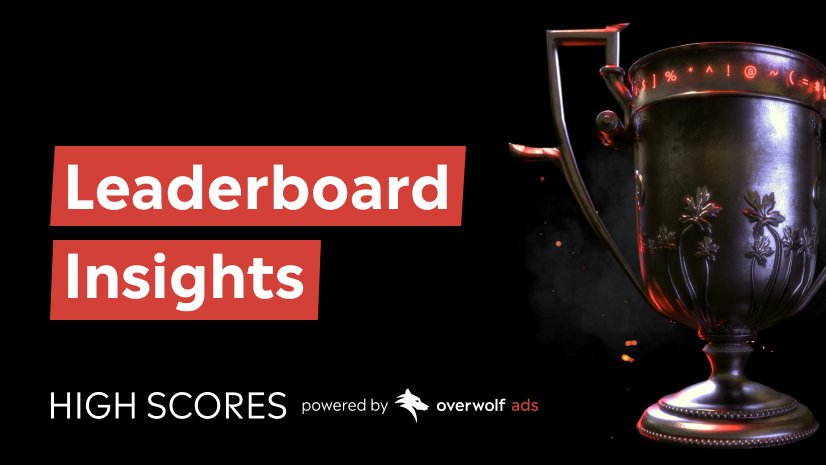
Welcome to this month’s special edition of High Scores Leaderboard Insights, where we bring you expert perspectives from industry leaders shaping the future of gaming marketing.
This time, we’re featuring Noam Korin, VP of Brand Partnerships, who breaks down what strong in-game creative really looks like, and the key practices that consistently make the difference.
By Noam Korin.
In an environment where skipping and ignoring ads is the norm, the right creative strategy is essential within in-game advertising to ensure high ROI and brand uplift. With an audience that is accustomed to having hundreds of notifications and intrusive ads, breaking through requires more than “just showing up”, it takes the right tone, the right visual, all delivered at the right time.
Attention is limited, and relevance isn’t optional. You can have an ambitious campaign with a big budget, but if the creative doesn’t feel like it fits, it gets dismissed - fast. Nonetheless, when it’s timed well, speaks the language, and aligns with what’s happening on the screen, the chances of your message impacting grow exponentially.
By following the three core principles listed below, brands and advertisers can shift from background noise to a presence that feels relevant and, most importantly, part of the overall gaming experience.
1. Reference Contextual Audience Data
Reaching gamers starts with relevance, and relevance starts with context. When an ad speaks directly to the player in terms of hardware set-up, the specific game they're playing, or even real-time in-game events, it doesn’t feel like an obstruction. It feels like it belongs.
Best-In-Class Example:

Intel, a brand built around performance, needed a way to get their message across and truly resonate with PC gamers still running outdated hardware.
By tapping into Overwolf Ads’ hardware and genre targeting, they were able to zero in on players whose outdated PC set ups couldn’t keep up and deliver a creative message that made the performance gap impossible to ignore.
Instead of a standard upgrade pitch, players were shown a stark visual comparison of what the upgrade would look like. This simple strategy of combining contextual audience data with the right targeting generated 92% viewability and a 78% video completion rate.
2. Speak Gamer Language
When trying to land a message mid-game, tone is everything. After all, it’s crucial that your message matches the energy of the moment and blends into the culture of what that moment represents to the player. Although standing out is the goal, it shouldn’t come at the cost of disrupting the flow or pulling players out of the moment for the wrong reasons.
Best-In-Class Example:
Pringles struck this balance by leaning into Overwolf’s Moment-Triggered Ad format. Their campaign activated custom ads after specific real-time in-game achievements such as an opponent elimination or a level win (peak emotional moment for players) and delivered a contextual message that became part of the celebration rather than break from it.
With lines like “GG! SPICED UP VICTORY!”, the tone was native to the real-time environment alongside matching Pringles’ bold tone-on-voice and the specific product promotion.
3. Immersion Immersion Immersion
Creative that invites players in is far more powerful than creative that simply talks at them. When players can engage with a brand in the flow of gameplay - not as an interruption, but as part of what they’re already doing - the message sticks. It becomes tied to the moment, to the feeling, to the play itself. And that’s what makes it memorable.
Best-In-Class Example:
Monster Energy understood this and executed it through a tournament activation timed with the launch of Call of Duty: Modern Warfare III. Rather than placing ads around the game, they leveraged Overwolf Ads to create an in-game experience that players could actively participate in.
With a launch-day tournament native to Monster’s identity, players competed for exclusive in-game rewards delivered during key moments through punchy, energy-fuelled messaging that stayed true to the brand’s voice.
The tournament drove over 65,000 matches played and more than 14,000 hours of active engagement, showing that when brands build experiences players want to be part of, the impact runs deeper.
Creative Frameworks That Win
Overwolf Ads is built around creative that fits the way gamers play. Every format and placement is designed to meet players where they are, which is always in-game, in the moment, and fully engaged. It’s not about forcing attention; it’s about showing up when attention is already at its peak.
Our creative strategy is grounded in three core frameworks:
- Contextual Targeting by hardware and genre, ensuring that each message speaks to the right player, at the right time
- Moment-Triggered Ad Formats that activate during real in-game events, whether it’s a win, a clutch revives, or a key elimination
- Reward-Based Tournament Activations that drive meaningful interaction by turning gameplay into brand touchpoints
These tools are effective because they deliver creative that feels native to the experience. Each one is designed to match the pace and context of gameplay, so the message lands without breaking immersion.
Today’s gamers expect relevance, creativity, and authenticity — and can certainly tell when something misses the mark. In a space where attention is limited and earned, creative is what makes the impact stick. It’s where awareness turns into connection, and where lasting brand value begins.